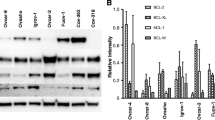Abstract
Background. Apoptosis is a cascade of events that is regulated by many factors. We studied the effects of interleukin-6 (IL-6) on chemotherapy-induced apoptosis in three human ovarian cancer cell lines (JV, GG, and NF).
Methods. Cells were treated with the anticancer drugs cis-diamminedichloroplatinum (II) (CDDP) and paclitaxel (Taxol; Bristol-Myers Squibb Pharmacessticals, Noble Park, Australia) over a period of 72 h. The treatments were repeated in combination with human recombinant IL-6 or anti-IL-6 monoclonal antibody (anti-IL-6 mAb). The induction of cell death was examined by morphology and by internucleosomal DNA fragmentation.
Results. Reduced cytotoxicity and fewer apoptotic cells were observed after treatment with CDDP or Taxol combined with IL-6 compared with treatment with CDDP or Taxol alone. However, treatment with CDDP or Taxol combined with anti-IL-6 mAb enhanced the cytotoxic effects of the drugs and increased the number of apoptotic cells. These findings indicated that apoptosis caused by CDDP or Taxol was influenced negatively by high doses of IL-6.
Conclusion. The use of CDDP or Taxol combined with anti-IL-6 mAb may have therapeutic value for patients with ovarian cancer.
Similar content being viewed by others
Author information
Authors and Affiliations
Additional information
Received: April 27, 1998 / Accepted: October 28, 1998
About this article
Cite this article
Ishioka, S., van Haaften-Day, C., Sagae, S. et al. Effects of interleukin-6 (IL-6) on chemotherapy-induced apoptosis in human ovarian cancer cell lines. Int J Clin Oncol 4, 84–89 (1999). https://doi.org/10.1007/s101470050032
Issue Date:
DOI: https://doi.org/10.1007/s101470050032




